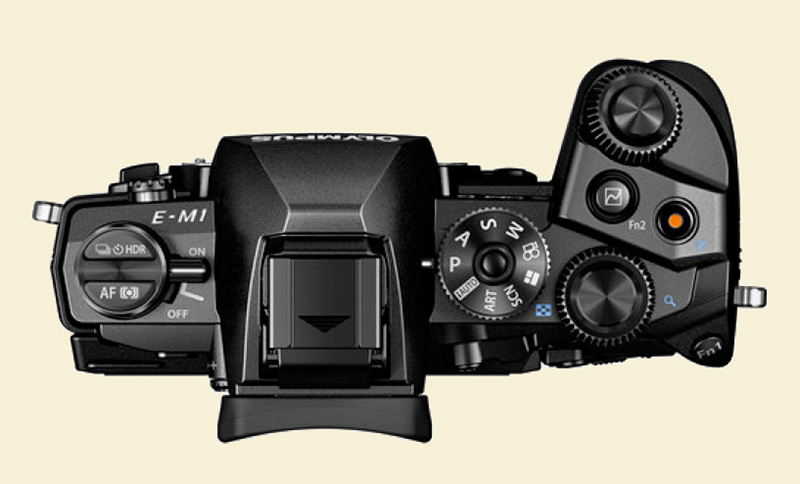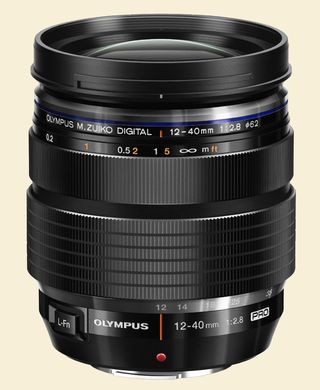 The early reviews of the OM-D E-M1 from Olympus—the long-promised and long-awaited "Professional Micro 4/3"—are already calling it the best Micro 4/3 camera yet. Weatherproof, shockproof, with lightning-fast autofocus, it's said to have the best electronic viewfinder ever and the best in-body image stabilization ever. If you like the Micro 4/3 System's peerless panoply of lens choices, you'll want to keep a sharp eye out for the collective wisdom that will really start to fly around the Web when the E-M1 ships less than two weeks from now.
The early reviews of the OM-D E-M1 from Olympus—the long-promised and long-awaited "Professional Micro 4/3"—are already calling it the best Micro 4/3 camera yet. Weatherproof, shockproof, with lightning-fast autofocus, it's said to have the best electronic viewfinder ever and the best in-body image stabilization ever. If you like the Micro 4/3 System's peerless panoply of lens choices, you'll want to keep a sharp eye out for the collective wisdom that will really start to fly around the Web when the E-M1 ships less than two weeks from now.
The question will be, will you actually be able to find anything in its huge junk-drawer of features and make it work for you surely and effectively? (Sentences like that are why I never get invited on the press junkets.)
Available now for pre-order from B&H Photo and Amazon.
By the way, Micro 4/3 is not selling at all well in this country, although it is very popular in parts of Asia. Of course, the attitude of photographers who actually care about pictures has always been, as long as they make what I need, I'm good. This whole deal with hobbyists being preoccupied with the business concerns of suppliers is a recent phenomenon; historically, photographers have mostly seen themselves as being outside of the mainstream market for photographic products and materials, going their own way after their own fashion, "doing their own thing" as the '60s expression had it. As long as they could get what they needed to do their work.
So Micro 4/3 might not be popular generally. But it's important here. I continue to think 4/3 is the best format, with the best balance of sensor size and quality, camera and lens size, and d-o-f considerations. (Even though I currently own two FF DSLRs, one APS-C mirrorless compact, and no small sensor digicams—and umpteen film cameras which I seldom use.)
Mike
ADDENDUM: I neglected to mention the other main point of the E-M1, besides its professional build quality. You probably remember the earlier 4/3 series of SLR digital cameras that, as the market sorted out during the aughts, failed to be fully competitive with the emerging standard of APS-C used by Canon and Nikon. Olympus and Panasonic revamped their plans and created the mirrorless category with Micro 4/3, which used the same size sensor but a different lensmount and really took advantage of the smaller sensor size by creating more compact cameras and lenses. The problem has been that although 4/3 lenses were usable on Micro 4/3 cameras from the first with an adapter, the 4/3 lenses were designed for phase-detect autofocus*, and Micro 4/3 cameras used on-chip contrast-detect* autofocus. The E-M1 is the first mirrorless Micro 4/3 camera that has both contrast-detect and phase-detect autofocus, meaning that the original 4/3 lenses now work virtually as well as native Micro 4/3 lenses on the camera. (You still need the adapter.)
And why does anyone care? Well, aside from the fact that many people still own 4/3 lenses, they are also some of the most beautiful lenses ever created for photography, bar none. The full usability of 4/3 lenses brings those lenses back into true viability for the format. It's actually not inconceivable that some photographers who never owned 4/3 lenses before might seek one or two of them out for use with the E-M1.

Complicating that issue even a little further, though, is Olympus's first PRO lens for Micro 4/3, the 12–40mm constant-aperture zoom that will follow the camera to market about five weeks later (late November or early December). This is a lens type that Olympus first completely mastered with the old 35–80mm ƒ/2.8 OM Zuiko first introduced with the mechanical-shuttered OM-3Ti film camera in 1994 (I think. I could have that wrong). One of the best zooms ever made at that time, that lens remained a connoisseur's secret, as it was manual focus and the world (and the camera market) had accepted autofocus by that time.
The tradition of constant-aperture standard zooms of the highest quality continued with the 12–35mm ƒ/2 constant-aperture lens first announced at PMA in 2005. The Big Kahuna of Olympus's SHG (super high grade) line, that lens also unfortunately continued Olympus's tradition of hiding its lights (i.e., its dazzling optical excellence) under a bushel, because by the time it actually arrived a few years later, the 4/3 format had essentially lost the DSLR wars to the by-then more widespread APS-C format. But it, too, was and is a really special lens.
Olympus avoids one error with the new PRO lens (full moniker: Olympus M. Zuiko Digital ED 12–40mm ƒ/2.8 PRO) in that it only costs $999, far less than the 14–35mm ƒ/2 4/3 lens, which is out of reach for many at $2,299 (and was higher still when it first came out). The new PRO lens might be ignored by some because of the bad smell of the corporate scandal Olympus is having a hard time putting behind it, or because of the aforementioned lack of wild popularity of the mirrorless category as a whole. But if the company follows true to form, the lucky souls who end up with this lens might well have a paragon to prize for years. With lenses now "bunched up at the top," there's no overriding need any
more to own a top-grade premium lens—you can do great work with some pretty ordinary and uncelebrated lenses, as long as you like what you have. But the differences are still
there for the trained (or jaded) eye, and those differences are still
capable of giving owner-users a lot of pleasure and satisfaction.
Here's the PRO lens at B&H Photo and Amazon.
Note that both the E-M1 camera and the 12–40mm PRO zoom are dustproof, splashproof, and freeze-proof.
*See the Wikipedia article on "Autofocus" if you want chapter and verse on what these terms mean.
Original contents copyright 2013 by Michael C. Johnston and/or the bylined author. All Rights Reserved. Links in this post may be to our affiliates; sales through affiliate links may benefit this site.
TOP's links!
(To see all the comments, click on the "Comments" link below.)
Featured Comments from:
Tom Simonsen: "I am torn between the Olympus E-M1 and Panasonic GX7. The E-M1 will work fine with my existing kit of 4/3 lenses; but I will get a much more compact kit with the GX7 and Micro 4/3 lenses. I also like the design of the GX7 better than the E-M1, but I suspect the E-M1 is going to handle better."
cfw: "A camera I paid $700 for two years ago now has a (KEH) resale value of
$79 in Excellent/Like New condition (and probably not much more than
that through eBay). The hammer in my tool box that I bought 20 years
ago has probably not decreased as much in value (and they make a lot
more hammers in the world than they do cameras). I think I'm jumping off
the acquisition train for several years."
David Kieltyka: "For me, Micro 4/3 is now the most versatile format around. Great
combo of size, weight, lens selection, image quality and DoF control. I
have a big rig too, a Pentax 645D, but it mostly lives on a
correspondingly big tripod. As I've gotten older size & weight have
become increasingly more important factors in choosing what I'm willing
to lug around on trips, treks and explorations. There's no 35mm camera
(I don't like the term 'full frame'...whatever its origin it often comes
off as snobbish if not arrogant) on the market with the E-M1's build
quality appreciably smaller and lighter than my Pentax! Not to mention
lens size and weight. So for me 35mm is now a legacy format...Contax
Aria and Pentax MX cameras with light, compact lenses and Provia,
Portra & HP5+ film. APS-C DSLRs have similar bulk/build quality
issues to 35mm. I do like the Fuji X system (I own an X-E1) but
lens-wise it's still a work in progress. So for me it's Micro 4/3, baby!"
Tom Hassler: "Have had mine for a few days now, and it is impressive. All the expected good stuff proves to be pretty much as promised. It is massively customizable (maybe too much so) but once done it's a 'set it and forget it' situation. I really appreciate being able to assign the functions I want to the buttons I prefer, not be stuck with an arrangement that some non-photographer engineer/designer might have thought best. Initial setup is a small investment of time over the life of the camera, with a big payoff."




